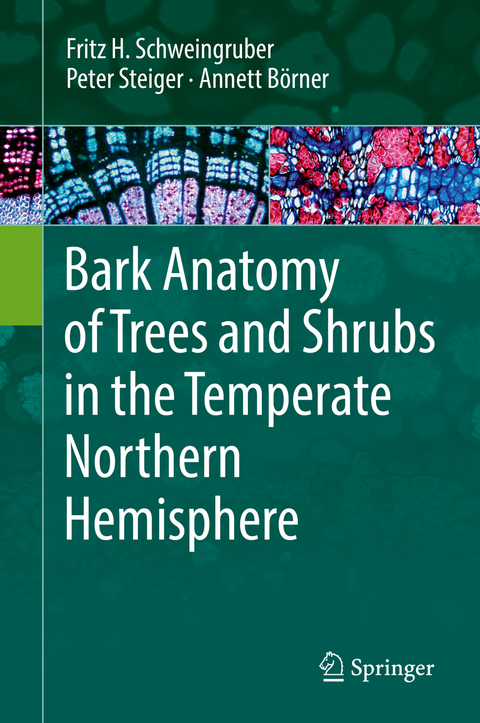
Bark Anatomy of Trees and Shrubs in the Temperate Northern Hemisphere
Springer International Publishing (Verlag)
978-3-030-14055-7 (ISBN)
This book presents the microscopic and macroscopic bark structure of more than 180 different tree and shrub species from Europe, Asia and North America. It is the first compendium to demonstrate the anatomical variability in bark since almost 70 years (Holdheide 1951). The introductory chapter explains with high-quality microphotographs the anatomical traits most important for identification and ecological interpretation of barks, and the monographic part demonstrates in text and pictures the species-specific patterns. The species treatments are grouped by their main biomes. Each species description first characterizes the macroscopic aspects with its main form, features and habitat with text and pictures of the whole plant and the barks in a young and old stage. This is followed by the microscopical description of each species. The microscopic photographs are based on double-stained slides, revealing the quality and distribution of unlignified and lignified tissues in low and highmagnification.
The book fills a scientific gap: Archeologists and soil scientists want to identify prehistoric and historical remnants. Ecophysiologists are interested in the distribution of conducting and non-conducting tissues in the phloem and xylem along the stem axis and the internal longevity of cells. Ecologists get information about internal defense mechanisms and technologists are enabled to recognize indicators relevant in biophysics and technology.
Fritz Hans SchweingruberSwiss Federal Research Institute WSLZurcherstrasse 1118903 Birmensdorf, Switzerlandfritz.schweingruber@wsl.ch Peter SteigerOberdorfstrasse 354118 Rodersdorf, Switzerlandpeter.steiger@me.com Annett BoernerCalyptra Pty LtdPO Box 808Melrose Park SA 5039, Australiaannett.boerner@gmx.net
Introduction.- The Boreal Taiga.- Subalpine and Subarctic Dwarf Shrubs.- Mountain Ranges in Eurasia.- Deciduous Forest of Temperate Europe.- Deciduous Forest of Submediterranean Europe.- Deciduous Forest of Eastern Asia.- Deciduous Forest of Eastern North America.- Coniferous Forest of Pacific North America.- Mediterranean Hard-Leaved Forest.
"The intended audience includes a very wide range of readers. Scientists and professionals of various disciplines from archaeology to ecophysiology, soils science to plant ecology will benefit from the book. ... The reader will appreciate the plant descriptions and photographs, which help to link the microscopic views to the scale at which we may have known the plants in our hikes and, in some cases, in our gardens." (Alan Crivellaro, Plant Science Bulletin, Vol. 66 (2), 2020)
“The intended audience includes a very wide range of readers. Scientists and professionals of various disciplines from archaeology to ecophysiology, soils science to plant ecology will benefit from the book. ... The reader will appreciate the plant descriptions and photographs, which help to link the microscopic views to the scale at which we may have known the plants in our hikes and, in some cases, in our gardens.” (Alan Crivellaro, Plant Science Bulletin, Vol. 66 (2), 2020)
| Erscheinungsdatum | 22.05.2019 |
|---|---|
| Zusatzinfo | VI, 394 p. 790 illus. in color. |
| Verlagsort | Cham |
| Sprache | englisch |
| Maße | 155 x 235 mm |
| Gewicht | 756 g |
| Themenwelt | Naturwissenschaften ► Biologie ► Botanik |
| Naturwissenschaften ► Biologie ► Ökologie / Naturschutz | |
| Weitere Fachgebiete ► Land- / Forstwirtschaft / Fischerei | |
| Schlagworte | Biological Microscopy • Cork or Phellem • Lignified Cells • Periderm • Primary and Secondary Phloem • Rhytidome • systematic botany • Taxonomical Bark Anatomy • Tertiary Boundary Layer • tree biology • tree trunk • Wood Science and Technology |
| ISBN-10 | 3-030-14055-5 / 3030140555 |
| ISBN-13 | 978-3-030-14055-7 / 9783030140557 |
| Zustand | Neuware |
| Haben Sie eine Frage zum Produkt? |
aus dem Bereich


